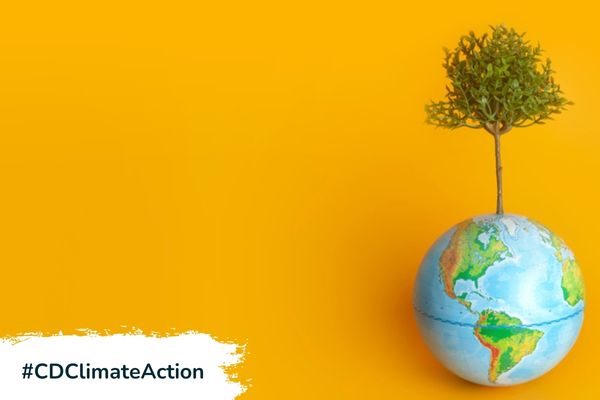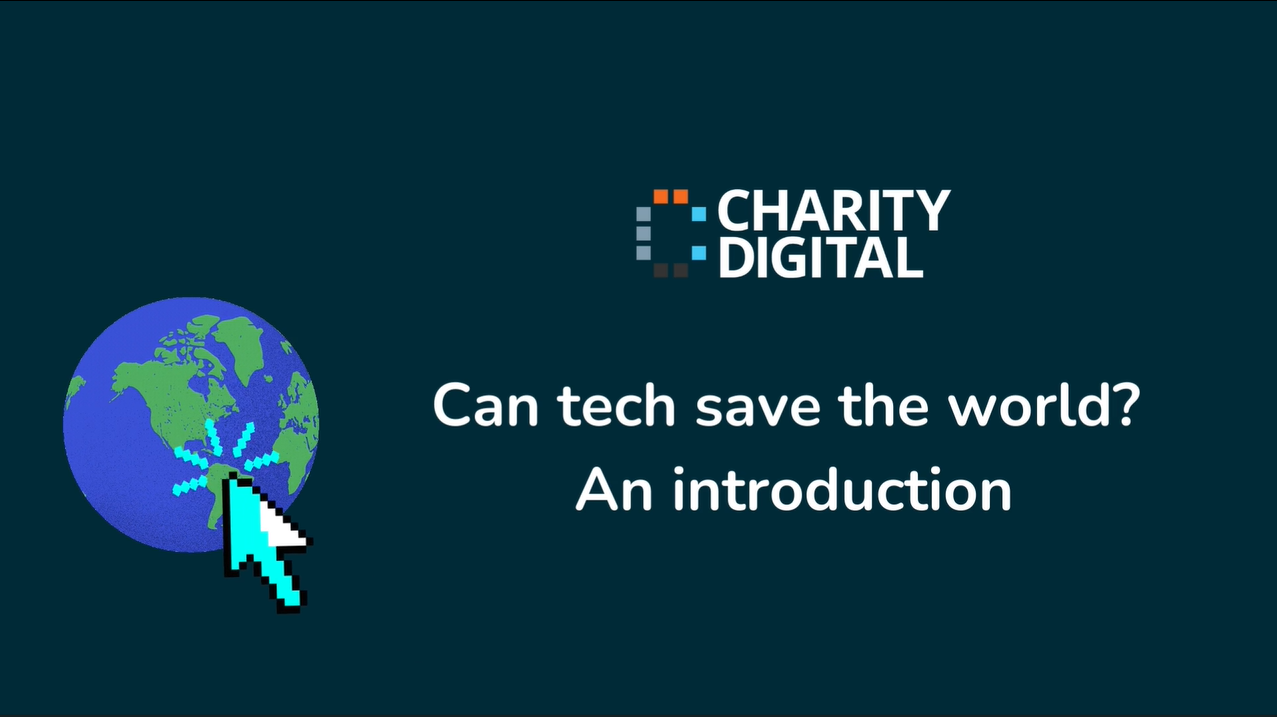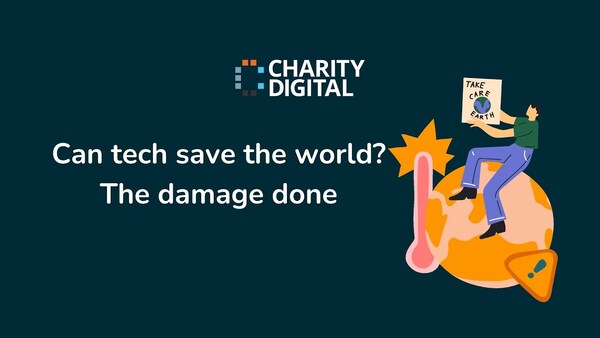Insights
INSIGHTS
All Topics
Can tech save the planet?
We look at the complex relationship between technology and the environment, exploring historical environmental problems, the unstoppable rise of green tech, the problem of solutionism, the need for behavioural change, and much more
Click to listen to the articleplay_arrow18:49
Tech plays a paradoxical role in the history of climate change: as both problem and solution. Consider, for example, that according to a 2019 study by the Shift Project, the world’s collective digital carbon footprint accounted for nearly 4% of all greenhouse emissions, comparable to levels emitted by the aviation industry.
And, worse still, consider that tech consumption has increased by almost 70% between 2013–20, according to the same study. That means the future greenhouse gas emissions coming from tech, if we don’t change the ways in which we consume, could prove catastrophic.
And most of us are part of that problem. Facebook’s 2.85 billion users each produce 12 grams of carbon dioxide annually by using the platform, according to information released by Meta. Just scrolling social media, streaming videos, playing with devices, and downloading games creates a huge carbon footprint. We often use tech without thought because we’re unaware of the impact.
It is undeniable that, at present, tech is a massive contributor to the climate crisis. It is also undeniable that, in the future, tech may well provide effective solutions to the climate crisis.
Tech is part of the problem, but it’s increasingly part of the solution. We know, for example, that elements of high-tech can actively limit and even reduce greenhouse gas emissions. Take Carbon capture and storage (CCS). CCS extracts CO2 from the atmosphere through air filters and ionic liquids, and through the support of natural carbon sinks and saline aquifers. And it has been quite successful, though perhaps not as successful as many had once hoped.
Tech can help us monitor emissions, too. Blockchain, for example, allows citizens to track corporate or government emissions, ensuring accountability at an international level. A recent report estimated that using the right tech could reduce global emissions by 17%, due to initiatives like using AI to improve efficiency of electric grids or satellites better monitoring environmental challenges.
And tech can help us react to the results of the climate crisis. According to the Global Commission on Adaptation, for example, solar-powered irrigation, weather alert systems, new crop varieties, and other adaptive measures can help avoid a drop-off in global agricultural yields by up to 30% by 2050.
The critical question of the future is not: should we use tech? The critical question is: how should we use tech? This article aims to answer that question. We will deep dive into the environmental issues caused by technology, the problem of environmental solutionism, the rise of green tech, the future role of tech in the climate crisis, and much more.
Skip to: The Jevons paradox: tech and the environment
Skip to: How technology damages the environment
Skip to: How technology continues to damage the environment
Skip to: The unstoppable rise of green tech
Skip to: Solutionism, or the danger of over-reliance on tech
Skip to: Green tech and the need for behavioural change
Skip to: Green tech and the future
The Jevons paradox: tech and the environment
In 1865, the English economist William Stanley Jevons noticed that efficiency of coal use led to the increased consumption of coal. Jevons argued that, contrary to common belief and indeed basic intuition, society could not rely on technological progress to reduce fuel consumption.
Jevons was espousing the ‘rebound effect’ that shows a reduction in gains from technologies due to other responses, often ones that no one could predict. We can broadly apply the Jevons paradox to the interaction of tech and the environment: tech has led to myriad gains, across the entire world, drastically improving lives, but it has also contributed significantly to the climate emergency.
Tech, as we shall see, is not the problem. The problem is our interaction with tech, the way in which we use tech, the choices we make as individuals and organisations, the national and supra-national regulatory systems that we follow, and myriad other factors. We need to change our relationship with tech, ensuring a more sustainable use in our present generation and beyond.
The paradox is complicated by the abovementioned fact: tech has proved a cause of the climate crisis, but it is also part of the solution. Simply put, tech is a problem, but not the problem. Humans are the problem. Tech is part of the solution, but not the solution. Humans are the solution.
How technology has damaged the environment
Let’s go back to the start. The word ‘technology’ refers to the application of scientific knowledge for practical purposes and the machinery, devices, and gadgets developed as a result. The Industrial Revolution brought about a rapid increase in new technologies, many of which had immense and impressive power. The new technologies and machineries included, among other things:
- The rise of transportation and communication, including the steam locomotive, automobile, telegraph, radio, and airplane – many of which depended on new energy resources
- The use of new basic materials, such as iron and steel, in manufacturing and construction
- The invention of new machines, including the famous spinning jenny and the power loom, many of which worked to limit the human energy expended in manufacturing
The Industrial Revolution fundamentally altered both the industrial and non-industrial spheres. Economic changes swept countries across the world, leading to a wider distribution of wealth, decline of land as an income source, boosts to international trade, political changes corresponding to economic shifts, the rise of class consciousness, cultural and social movements, and much more.
But, despite that change, despite the rising smoke from smokestacks, despite the literal altering of landscapes from the rural to urban, despite the shift from William Blake’s “green and pleasant lands” to “dark satanic mills”, an awareness of the environmental costs of that tech was largely absent.
Research suggests that global warming began as a result of the above changes. And with many new technologies continuing to advance at a much larger scale up until the present day, alongside a host of more damaging technologies, it is unsurprising that greenhouse emissions have skyrocketed.
How technology continues to damage the environment
We live in a period of rapid change. Tech developments revolutionise our way of life on a daily basis, with the latest apps going straight to our phones, the latest gadgets advertised on TVs and high streets, and the release of an upgraded device causing queues around blocks around the world.
But, at the same time, the use of that tech pushes us further towards climate emergency and resource scarcity. And, due to the increasing global population and the increasing use of tech among that population, levels of natural resource depletion, waste and electronic-waste, greenhouse gas emissions, and water and air pollution are also drastically increasing.
The science paints a clear picture of the problem. In 1995, an international group of scientists known as the Intergovernmental Panel on Climate Change issued its first public statement, noting the “discernible human influence” on climate change, examining evidence from ice cores, ocean beds, tree rings, pollen remains, and other essential areas. Drilling ice from Antarctica and Greenland has shown differences in the atmosphere from as far back as 800,000 years ago and satellite monitoring of the sun has made clear that radiation has not increased, despite rising temperatures on Earth.
The Columbia Climate School shows that CO2 levels are 40% higher than they were prior to the Industrial Revolution, while there is 2.5 times as much methane in the atmosphere as before the 18th century. While some methane is natural (from wetlands, volcanoes, and sediments), the vast majority of emissions now arise from oil and gas production, livestock farming, and landfills.
The 21st Century has already come to bear many of the warnings issued in 1995 by scientists concerned about the human impact on the climate, including rising oceans, droughts, storms, and heatwaves. Our ecosystems have suffered, with extinction occurring at 1,000 times the natural rate, and heat has continued to increase: the 15 hottest years in history have all occurred since 1998.
The above may seem daunting. But awareness provides hope. We know that human activities are a primary driver of climate change. And we know exactly which activities are causing the most damage. And we know, too, that technology is an increasing problem. So we need to change our behaviour and figure out the best way to use tech as part of the solution, not part of the problem.
The unstoppable rise of green technology
Tech has damaged and continues to damage the environment. But the future is unwritten, and we are equipped with a new awareness. That awareness is perhaps best seen in the rise of green tech.
Green tech is a nebulous term, one that is used to describe any tech that boasts green credentials. Green tech is anything that aims to mitigate, reduce, or reverse the effects of human-caused climate change. And such tech is becoming more and more popular. The market for tech aimed at reducing emissions reached $755 billion in 2021, a 25% rise as compared to 2020, according to Bloomberg.
Green tech is perhaps best divided into groups, all of which are rising at different rates. The first group is perhaps the most important. These are the day-to-day technologies, the eco-friendly and energy-efficient devices, often small-scale, often used at a personal or organisation-wide level.
These items are already in use and organisations are constantly developing new and more energy-efficient products. Examples of such tech include:
- Smart metres
- Energy-efficient lightbulbs
- Thermostatic radiator valves
- Refurbished hardware
- Recycled electrics
The second group exists at a larger scale. It consists of tech that makes projects more energy efficient, introducing green tech into operations from a top-down organisational level, or throughout an entire sector or industry. The large-scale green tech includes, among other things:
- Green architecture to improve sustainability
- Vertical farming to use less land and less water
- Self-sufficient buildings that produce their own power
- Electric transport in various forms
Then you have the third group, the so-called heroic green tech, the stuff that can actively reduce carbon emissions (not just limit emissions), the stuff that receives billions of pounds of investment by philanthropists and governments and international bodies. Here are some key examples:
All of the above tech plays a vital role in protecting the environment. Individuals and organisations need to audit the current tech they use, consider the green tech that would reduce their carbon footprint, and broadly think about the best ways to implement and use that tech.
Solutionism, or the danger of over-reliance on tech
It’s important at this stage to issue a warning: green tech will not save the planet. Not alone, at least. The belief that heroic tech will arrive and provide a quick answer has been profoundly detrimental to climate action over the past decades. It’s a form of solutionism that damages the climate cause.
Solutionism is a term coined by Evgeny Morozov in his best-selling book on smart technologies and big data: To Save Everything, Click Here. Solutionism refers to the idea that, given the right code, algorithms, and robots, technology can solve all of our problems, effectively making life “frictionless” and trouble-free, creating the sort of utopia that seldom features in science fiction.
As Naomi Klein explains in Capitalism vs The Climate, a point echoed by David Wallace-Wells in The Uninhabitable Earth, tech will not provide a fix-all solution to the crisis. Many still harbour the belief – one perhaps built in blind optimism, perhaps built in psychic numbing – that some random tech genius will come up with a one-stop solution, solving the climate crisis in one fell swoop, allowing us to continue along our trajectory of infinite consumption in a world of finite resources.
That is very unlikely. It is also, unfortunately, a belief that has been firmly held in corridors of power since at least the publication of Rachel Carson’s Silent Spring in 1962, a belief that was re-affirmed when Wallace Broecker brought the concept of global warming to the masses in 1975, re-affirmed again and again throughout more than half a century of awareness of climate degradation. And, of course, that form of solutionism is a belief too many still hold today.
To put it another way: the failure with solutionism has been the absence of solutions. We’ve held the belief in a tech solution to greenhouse emissions for more than half a century. And yet, according to data published by NASA, CO2 is currently at its highest point in more than two million years. Pre-industrial CO2 levels were around 280 parts per million (PPM). In 2023, we are close to 420 PPM.
We cannot wait around hoping for a miracle, especially when we can take action ourselves. Tech can be part of the solution, but only when matched with personal, organisational, national, and international action. In short, we all have to take responsibility, we all have to act.
Green tech and the need for behavioural change
The effective change of human behaviour depends on increasing the uptake of positive actions, such as a reliance on energy-efficient tech, and reducing negative actions, such as a reliance on energy-inefficient tech. Behaviour change largely depends on various incentives and disincentives, ranging from sensory responses, social norms, model behaviours, laws and regulations, and much more.
Governments have failed to put forward effective climate change legislation, failed to effectively change behaviour through regulatory incentives. But we have seen an increase in awareness driving decisions, particularly around climate change. According to a Business Wire report, for example, more than a third of global consumers will pay more if a product has sustainable credentials. The same report found that 85% of consumers have become “greener” in their purchasing.
Economists have long touted the virtues of consumer information. Transparent information allows effective market competition, undermines oligopolies, avoids corruption and exploitation, and increases trust. Consumers want to support green companies, but the information has not always been transparent, as seen in the rise of greenwashing, the cherry-picking of statistics, ESG reporting that suits company needs, and the perpetual promises of green futures despite no present action.
The good news is that green tech supports greater transparency and can drastically boost consumer information. Green tech does not simply account for the devices or machinery that directly limits or reduces emissions, but also the tech that helps us all to monitor emissions. Green tech, as mentioned, can help us track corporations and governments. Green tech can monitor environmental variables in different locations, such as the levels of air pollution, waste management, water management, and cold chain monitoring, ensuring that we are taking the appropriate action and alerting us to any bad faith actors at a local, national, and international level.
Green tech is not just vital in terms of machines that limit or reduce emissions, but also as a catalyst to help us take large steps to reduce emissions. It will help to change our behaviour, the behaviour of the people around us, and the behaviour of people in power. Machines will not save the planet, but alongside robust consumer information, monitoring to hold the powerful to account, incentives to protect our planet, and effective behavioural change, green tech may just prove essential.
Green tech and the future
We began the piece by suggesting that tech is part of the problem and part of the solution. But perhaps we can develop the paradox, bringing it back to the human: tech can be part of the problem or part of the solution. And it is us, as humans occupying the planet, that need to make that choice.
We need to use the right tech in the right way. We need to stop waiting around for a magical fix-all solution and welcome incremental developments, the little and large steps that lead to real change. We need to shift our behaviours, particularly in terms of consumption, and welcome the green tech that enables that shift. Ultimately, we need to embrace tech, to ensure that it supports our various journeys towards sustainability, to ensure that green tech forms part of the solution.
Sign up for our newsletter
Click above to receive the latest sustainability content straight to your inbox
Ioan Marc Jones
More on this topic
Recommended Products
Recommended Products
17 May 2024by Ioan Marc Jones
A guide to mental health awareness
17 May 2024by Ioan Marc Jones
Everything you need to know about the Charity Commission
16 May 2024by Josie Sparling
Why digital inaccessibility is everyone’s problem – and how to fix it
Our Events
Webinar: A charity guide to Meta Quest VR
Join us on the 30th of May, where we will explain more about how VR technology works and how it can help charities, hearing from organisations where the technology has already made a difference.
We use cookies so we can provide you with the best online experience. By continuing to browse this site you are agreeing to our use of cookies. Click on the banner to find out more.






















